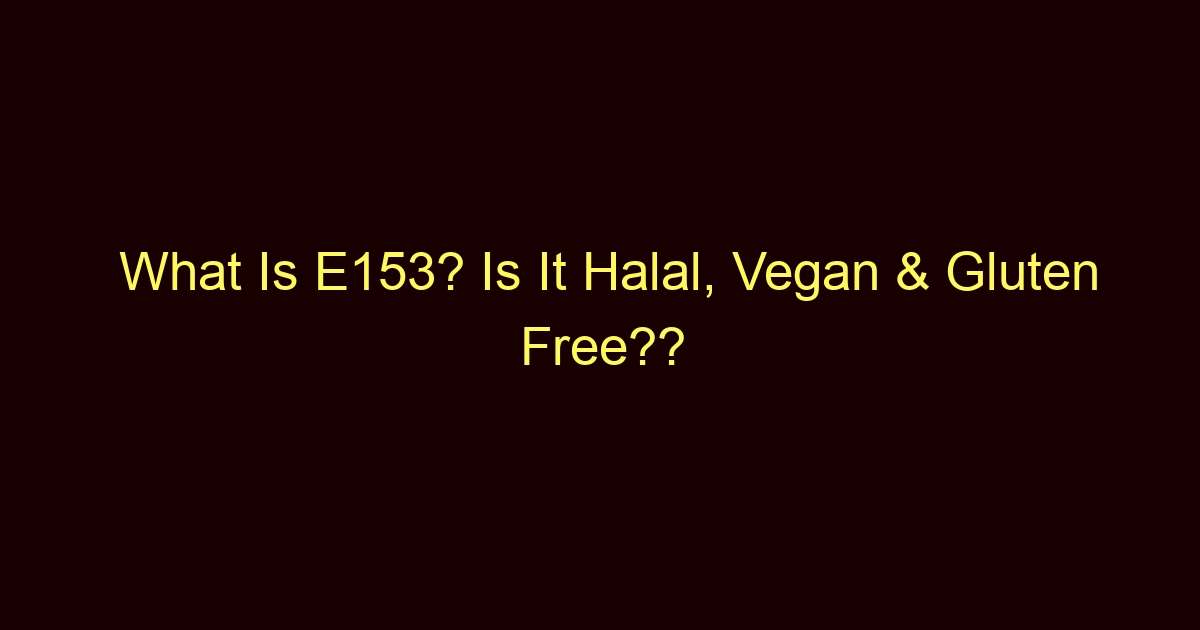The labyrinth of the modern food industry is filled with codes, symbols, and abbreviations. Decoding these can often feel like a daunting task. With the evolving dietary needs and concerns of today’s consumers, understanding what we consume becomes paramount. In the light of this backdrop, let’s delve into the enigma known as E153, or Carbon Black.
What is E153?
E153, colloquially known as Carbon Black, Vegetable Carbon, or Lamp Black, is a black dye used as a food coloring. Made from vegetable origin by charring certain plant materials, E153 is especially prevalent in confectionery products to give them a distinct, dark hue. Its use dates back to ancient times, where it was employed for its intense coloring properties, both in food and in various artistic pursuits.
While it may sound somewhat sinister, given that it’s derived from charring, E153 is essentially just a very pure form of natural carbon. But, like most food additives, its usage in the food industry has not been without controversy. Concerns have been raised regarding its purity and the possibility of containing impurities that could be harmful to health.
The depth of color it provides and its natural derivation might make it seem like an obvious choice for food coloration. However, the European Food Safety Authority (EFSA) has expressed reservations due to potential health concerns, which has made some food manufacturers reconsider its inclusion in their products.
How is E153 Made?
The creation of E153 involves charring plant materials in a controlled environment. This controlled combustion of vegetable matter, often wood or coconut shells, leads to the formation of a dark powdery substance – the Carbon Black. Once produced, this substance undergoes purification processes to remove any harmful impurities before it’s deemed fit for consumption.
To ensure safety and consistency, the production of Carbon Black for food application is regulated and monitored. Despite its natural origin, the process ensures that the final product is as pure as possible, meeting the necessary food safety standards.
Is E153 Halal?
Yes, E153, when derived from plant sources, is considered Halal. It is essentially burnt plant material and does not involve the use of animals, alcohol, insects, or any Haram components. However, it’s always prudent for Muslim consumers to check for Halal certification, especially if the origin of the Carbon Black isn’t specified, as variations in sourcing and production methods could potentially affect its Halal status.
Is E153 Vegan?
Yes, when sourced from plants, E153 is Vegan. Given its derivation from vegetable materials, it doesn’t involve animal exploitation or by-products. Nevertheless, vegans might want to ensure that the Carbon Black they consume hasn’t been tested on animals, keeping in line with the broader vegan ethos.
Is E153 Gluten Free?
Yes, E153 or Carbon Black is inherently gluten-free. Given that it’s derived from burning vegetable materials, it doesn’t contain wheat, barley, rye, or any gluten-containing grains. However, those with severe gluten intolerances or celiac disease should always cross-check product labels to ensure no cross-contamination has occurred during processing.
E153: Is It Safe or Harmful?
The jury is somewhat out on this. The European Food Safety Authority (EFSA) has been circumspect regarding E153. While it’s not classified as a carcinogen, concerns relate to impurities that might be present in the food-grade Carbon Black, which could pose health risks.
It’s worth noting that E153 is banned as a food additive in the U.S. but is permitted in the EU, albeit with restrictions. Its usage levels and the products it can be added to are stringently regulated.
Consumers should also be aware that Carbon Black used in non-food products, like printer inks or cosmetics, does not adhere to the same stringent standards as food-grade Carbon Black. Hence, while it’s permitted in certain food products, moderation and informed choices are crucial.
Final Thoughts
The food industry and its vast array of additives, like E153, are like pieces of a complex puzzle. With each piece having its place, purpose, and concerns, it’s up to the informed consumer to navigate this maze. Carbon Black, with its rich history and modern controversies, offers a dark hue not just to our sweets but also to the canvas of our food landscape. As we continue to explore and understand these additives, the age-old principle of balance and moderation remains timeless.

